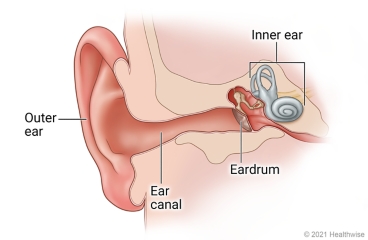Swimmer's Ear in Children: Care Instructions
Overview

Swimmer's ear (otitis externa) is inflammation or infection of the ear canal. This is the passage that leads
from the outer ear to the eardrum. Any water, sand, or other debris that gets into the ear canal and stays
there can cause swimmer's ear. Putting cotton swabs or other items in the ear to clean it can also cause this
problem.
Swimmer's ear can be very painful. You can treat the pain and infection with medicines. Your child should
feel better in a few days.
Follow-up care is a key part of your child's treatment and safety. Be sure to make and go to all
appointments, and call your doctor if your child is having problems. It's also a good idea to know your
child's test results and keep a list of the medicines your child takes.
How can you care for your child at home?
Cleaning and care
-
Use antibiotic drops as your doctor directs.
-
Do not insert eardrops (other than the antibiotic eardrops) or anything else into your child's ear unless
your doctor has told you to.
-
Avoid getting water in your child's ear until the problem clears up. Use cotton lightly coated with
petroleum jelly as an earplug. Do not use plastic earplugs.
-
Use a hair dryer to carefully dry the ear after your child showers. Make sure the dryer is on the lowest
heat setting.
-
To ease ear pain, hold a warm washcloth against your child's ear.
-
Be safe with medicines. Read and follow all instructions on the label.
-
If the doctor gave your child a prescription medicine for pain, give it as prescribed.
-
If your child is not taking a prescription pain medicine, ask your doctor if your child can take an
over-the-counter medicine.
-
Do not give aspirin to anyone younger than 20. It has been linked to Reye syndrome, a serious illness.
Inserting eardrops
-
Warm the drops to body temperature by rolling the container in your hands. Or you can place it in a cup of
warm water for a few minutes.
-
Have your child lie down, with your child's ear facing up. For a small child, you can try another
technique. Hold the child on your lap with the child's legs around your waist and the child's head on your
knees.
-
Place drops inside the ear. Follow your doctor's instructions (or the directions on the prescription or
label) for how many drops to put in the ear. Gently wiggle the outer ear or pull the ear up and back to help
the drops get into the ear.
-
It's important to keep the liquid in the ear canal for 3 to 5 minutes.
When should you call for help?
 Call your
doctor now or seek immediate medical care if:
Call your
doctor now or seek immediate medical care if:
Watch closely for changes in your child's health, and be sure to contact your doctor if:
Current as of: September 27, 2023
Content Version: 14.0
Care instructions adapted under license by your
healthcare professional. If you have questions about a medical condition or this instruction, always ask
your healthcare professional. Healthwise, Incorporated disclaims any warranty or liability for your use of
this information.